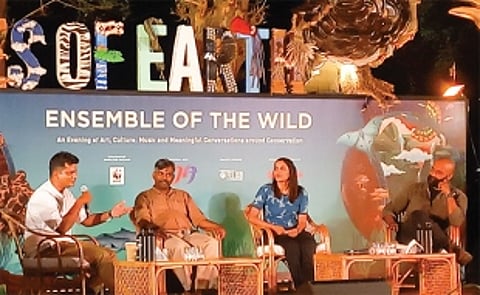

Goa’s wild spaces which are part of Western Ghats are filled with stories, such stories were shared by Goa’s wildlife experts like Paresh Porob, assistant Conservator of Forests, Goa Forest Department, Dr Nandini Velho, Project Lead, Canopy Collective and ORA India Fellow, and Benhail Antao, wildlife rescuer and National Geographic show presenter at ‘Snakes SOS: Goa’s Wildest’.
They were speaking on the topic, ‘Tales from the Wild: Exploring
Goa – A Western Ghats Wonderland – in association with the World Wide Fund for
Nature-India (WWF-India)’ on January 5 at Panjim Gymkhana. The discussion was
moderated by Aditya Kakodkar, Senior Coordinator, Marine Conservation, WWF-India
Goa Office.
This discussion was part of ‘Ensemble of the Wild: An Evening of
Art, Culture, Music and Meaningful Conversations Around Conservation’, a
curtain-raiser event of Echoes of Earth, a music festival that will be held
from February 2 to 4 at Chopdem.
Dr Nandini Velho, who
started studying Goa’s forests right from her childhood, shared an anecdote of
how discovering a forest bird, Malabar trogon, during a birding activity at
Tambdi Surla became a turning point in her life to become a wildlife biologist.
Paresh Porob stated
that during a tiger census in Cotigao forest in the year 1993 as a volunteer,
encountered a sloth bear and a cub while exploring the forest on foot. He also
shared an interesting story of how he as a forest officer was instrumental in
bringing together a rescued leopard cub to its mother. He said that we have now
stopped sharing such stories with our children. “We need to tell children such
stories about our wildlife. Instead, we tell them about phones, brands, etc.
Thus, the children are missing a connection with nature. And I believe once you
start connecting you start valuing it,” stated Paresh.
Benhail recollected
how he as a child was involved in snake rescues but used to kill them, as he
was not aware of them. But when he saw how helpless they were he realized of
finding another way to do it. Thus, he ventured into wildlife rescue and
conservation. He shared how one day he got a call to rescue a species that
locals described as a creature with big eyes that looked like a monkey. They
even considered it as a bad omen. He then discovered it as a slender loris, a
nocturnal primate. At that point, he realized the wealth of Goa’s forests which
even locals are not aware of and it is a home to many such species that need
protection.
Speaking of her
wildlife encounters, Dr Nandini Velho spoke about two contrasting events. When
she discovered bioluminescent fungus in forests seen during monsoon, it was a
moment of joy and wonder. But at the same time, the bioluminescence in our
oceans is not such a happy site as it is due to hypoxic conditions (low oxygen)
in the Arabian Sea.
Benhail, who is
mainly into snake rescues, mentioned one about a cobra, who was covered with
melted tarmac. He spent 22 hours clearing it as its eyes, mouth, and nostrils
were covered with it. But he succeeded and then released the snake in the wild.
All panelists spoke
about the ills of garbage and habitat loss which is directly affecting the
wildlife. Paresh mentioned that now langurs who are leaf eaters have become fruit
eaters and bonnet macaques have evolved from fruit eaters to eating any part of
the plant or tree including the bark. He also stated now wildlife encounters
have become common in human habitats but that does not mean that their
population is increasing.
Benhail mentioned
more venomous species of snakes found in cities like Mapusa, Margao, and Panjim
and more non-venomous ones found in villages. This indicates an imbalance of
species in urban spaces, according to him.
While speaking on the
topic of conservation, Paressh stated that now we have so many laws and acts
but our ancestors even without them managed and conserved our wildlife in a
much better way and documented it through folklore, songs, etc. He added, “The
main challenge is no sense of belonging. If we can develop it we can get over
many challenges. Also, ecology has to be linked to the economy and that link
has to be ethical.”
Benhail
advocated coexistence with wildlife around us. Dr Nandini Velho said that we
can tackle the challenges through information, action and most importantly
empowering ourselves to conserve our habitats through questioning and action on
the ground.